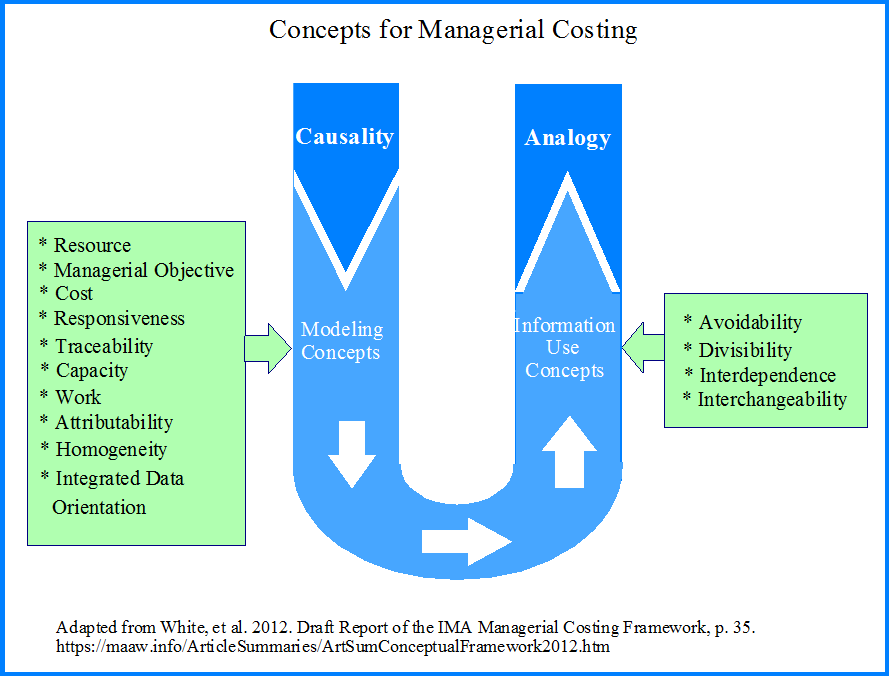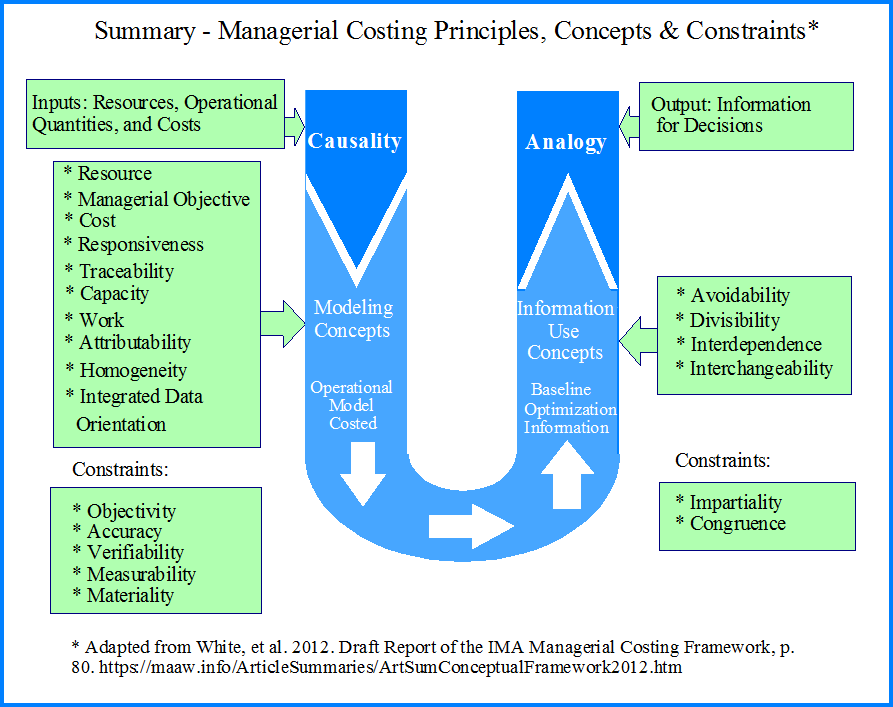
Summary by James R. Martin, Ph.D., CMA
Professor Emeritus, University of South Florida
Framework for Management Accounting Main Page
The purpose of the conceptual framework is to improve managerial costing by providing a structure to objectively evaluate various approaches to costing and apply them to internal decision support, i.e., to improve the operational optimization decisions made by managers and employees. The structure includes a set of principles, concepts and constraints. My note provides a brief sketch of the 128 page framework draft.
Section I. Objective of Managerial Costing (pp. 12-15)
The objective is to provide a monetary reflection of the utilization of the organizations resources and the related cause and effect relationships including past, present, and future enterprise economic activities.
Section II. Scope of Managerial costing (pp. 16-21)
To provide the following:
A. An accurate objective cost model of the organization reflecting the use of the organization's resources.
B. Timely and flexible information for decision support.
C. Insight related to the marginal or incremental aspects of various alternatives.
D. A model of the cause and effect relationships between outputs and the required inputs.
E. Accurate values for all support and production operations in monetary terms.
F. Information to aid decisions related to optimization, growth, and strategic objectives.
G. Information to evaluate and improve performance.
H. The basis for exploratory and predictive managerial activities.
Section III: The Characteristics of Managerial Costing (p. 22)
The characteristics of managerial costing include principles, concepts and constraints as indicated in the graphic below adapted from an illustration on page 22.

A Framework for the Qualitative Characteristics of Managerial Costing (p. 23)
The framework is based on the principles of causality and analogy. "Causality is the basis of all inferences in the scientific method"... and "the basis for discerning truth in cost modeling and its decision-support information". "Truth in cost modeling means reflecting the reality of the operations being modeled." (p. 28) Causality involves capturing the quantitative cause and effect relationships.
The correspondence definition of causality: "The relation between a managerial objective's quantitative output and the input quantities consumed if the output is to be achieved." (p. 29) The authors note that there are strong (explicitly quantified) and weak (clear association) forms of causality. (p. 30)
Analogy - "The use of causal insights to infer past or future causes or effects." Analogy is the basis for the application of causal information towards optimization actions. (p. 31).
Section III. B: Concepts for Managerial Costing
Causality and Analogy are connected by modeling and information use concepts as illustrated in the graphic below adapted from an illustration on page 35. Modeling refers to "the measurement and capture of an organization's resources and costs."

The modeling concepts under causality on the left hand side of the graphic are defined and discussed on pages 36-59. A summary table appears on page 61 with the definitions quoted below.
Resource - A definitive component of an enterprise acquired to generate future benefits.
Managerial Objective - A specific result or outcome of the application or provision of resources that management chooses to monitor for the purpose of enabling one or more managerial activities.
Cost - A monetary measure of (1) consuming a resource or its output to achieve a specific managerial objective, or (2) making a resource or its output available and not using it.
Responsiveness - The correlation between a particular managerial objective’s output quantity and the input quantities required to produce that output.
Traceability - A characteristic of an input unit that permits it to be identified in its entirety with a specific managerial objective on the basis of verifiable transaction records.
Capacity - The potential for a resource to do work.
Work - A measure of the specific nature of units of resource output.
Attributability - The responsiveness of inputs to decisions that change the provision and/or consumption of resources.
Homogeneity - A characteristic of one or more resources or inputs of similar technology or skill that allow for their costs to be governed by the same set of determinants and in an identical manner.
Integrated Data Orientation - Information about an organization’s economic resources, events, and their corresponding monetary values, free from traditional accounting conventions, which allows for the aggregation of elementary data elements and their values for any purpose.
The information use concepts under analogy on the right hand side of the graphic are defined and discussed on pp. 64-67. A summary table appears on page 68 with the definitions quoted below.
Primarily relevant to analysis:
Avoidability - A characteristic of an input that allows for the input (and hence its costs) to be eliminated as a result of a decision.
Divisibility - A characteristic of a resource that allows it to be associated in its entirety with the change in a managerial objective’s output resulting from a decision.
Primarily relevant to decision making:
Interdependence - A relation between managerial objectives that occurs because of a decision to use resources to achieve one objective that affects the amount or quality of resources required to achieve other objectives.
Interchangeability - An attribute of any two or more resources or resource outputs that can be substituted for each other without affecting the costs of the other resources that are required to carry out the activities to which the interchangeable resources are devoted.
Section III. C: Constraints for Managerial Costing (p. 70)
Five modeling constraints include objectivity, accuracy, verifiability, measurability, and materiality. These constraints are defined on pages 72-76. Two information use constraints include impartiality and congruence. A summary table for the seven constraints appears on page 79 with the definitions indicated below.
Modeling Constraints:
Objectivity - A characteristic of a cost model that shows it to be free of any biases.
Accuracy - The degree to which MA information reflects the concepts you intended to model.
Verifiability - A characteristic of modeling information that leads independent reviewers to arrive at similar conclusions.
Measurability - A characteristic of a causal relationship enabling it to be quantified with a reasonable amount of effort.
Materiality - A characteristic of cost modeling that would allow for simplification without compromising managers’ decision making needs.
Information Use Constraints:
Impartiality - The unbiased consideration of all resource application alternatives.
Congruence - The interdependence of individual managerial actions to attempt to achieve both individual and enterprise objectives in an optimal manner.
A summary graphic for the principles, concepts and constraints appears on page 80. The following graphic provides an adaptation of this illustration.

Section IV: The Framework in Operation (p. 81)
Part IV. A: Evaluating a Company's Operations and Strategy for Modeling
Part IV. B: Model Design and Construction (p. 86)
Cost modeling involves six steps as follows:
A. Identify the organization's resources and their costs.
B. Identify the objectives required to support management's needs.
C. Develop an understanding of the cause and effect relationships between the objectives.
D. Design a model that captures the objectives and cause and effect relationships.
E. Include the scope, intended uses, required inputs and outputs, and underlying assumptions and limitations of the model.
F. Apply and maintain the model.
Illustrative Scenarios for Designing a Cost Model (p. 88)
Illustration of modeling concepts and information use concepts. (p.89-100)
Scenario 1. Fuel for Flights with Fuel Purchased for Each Flight.
Scenario 2. Fuel for Flights with Fuel Purchased in Bulk Quantities
Scenario 3. Pilots for Flights
Scenario 4. Pilots for Flights—with Unused Pilot Time Each Day
Scenario 5. Pilots for One More Flight
Scenario 6. Adding the Customer Dimension
Part IV. C: Implementation Factors (p. 101)
This section is devoted to a discussion of designing a cost model for an organization based on the principles, concepts, and constraints outlined above. Some points in the section include the following. Although software is needed, software selection is not the place to start in designing a managerial costing system. Instead the first step involves developing an understanding of the organization's operations, strategic objectives, optimization decisions, resources, processes, costs, and information needs. Project management should be used to ensure that improvement efforts are achieved, implemented and become part of the system. Software should be chosen to fit the managerial costing system rather than the other way around. The appropriate choice may include ERP, Best-of-Breed, or Business Intelligence software. For example, ERP and Business Intelligence software can be used to create different views of the organization, e.g., operations control, logistics/supply chain, and financial reporting. Change management, or overcoming resistance to change is also a key to the successful implementation of a new managerial costing system. "Change will only result when people feel compelled to change." (p. 106) The authors recommend applying the Socratic method to create discomfort to overcome resistance to change.
Part IV. D: An Organization's Acceptance of Managerial Costing (p. 108)
Section V. Call to Action (p. 113)
“Why should management accountants adopt, foster, and promote the framework?”
"This is not a call to action based on altruistic motives. It instead recognizes that a house is built from the bottom up - brick by brick, frame by frame, whether that house is your career, the company you work for that you and other stakeholders are vested in, or your nation’s economic well-being. No profession rivals management accounting in determining how efficiently and effectively that house is built and maintained. As manifested in the principles anchoring the managerial costing framework, the accounting profession holds one of the keys to enable better decision making. Every decision that managers, companies, and governments make is a resource application decision. Will the management accounting profession rise to the challenge to have a real and substantive impact on cost methodology in an environment in dire need of sound guidance? An adapted Albert Einstein quote expresses the profession’s challenge appropriately: "The management accountant must not merely wait and criticize, he must embrace, defend and promote the cause the best he can. The fate of the profession will be such as the profession deserves."" (pp. 116-117)
Appendix: Truth as a Foundation for Managerial Costing (p. 118)
"Telling it like it is".
"A modern version of the correspondence definition of truth is: A statement or opinion is true if what it corresponds to is a fact (Angeles, 1992, 317). For managerial costing, this means corresponding to the facts of the operations that it strives to provide insights into. The law of non-contradiction, epitomized in the correspondence definition of truth, serves to bridge the gap and anchor managerial costing to a bedrock of truth." (pp. 121-122)
"The foundation of truth for managerial costing is absolutely essential, and its essence must guide every aspect of managerial cost modeling. This is the premise upon which the managerial costing framework is based as it strives to provide the structure and the guidance to create information that will better support managers." (p. 125)
_________________________________________________________
Related summaries:
Appelbaum, D., A. Kogan and M. A. Vasarhelyi. 2017. An introduction to data analysis for auditors and accountants. The CPA Journal (February): 32-37. (Summary).
Appelbaum, D., A. Kogan, M. Vasarhelyi and Z. Yan. 2017. Impact of business analytics and enterprise systems on managerial accounting. International Journal of Accounting Information Systems (25): 29-44. (Summary).
Tiessen, P. and J. H. Waterhouse. 1983. Towards a descriptive theory of management accounting. Accounting, Organizations and Society 8(2-3): 251-267. (Summary).
Van der Merwe, A. 2007. Management accounting philosophy I: Gaping holes in our foundation. Cost Management (May/June): 5-11. (Summary).
Van der Merwe, A. 2007. Management accounting philosophy II: The cornerstones of restoration. Cost Management (September/October): 26-33. (Summary).
Van der Merwe, A. 2007. Management accounting philosophy III: The management accounting evaluation framework. Cost Management (November/December): 20-29. (Summary).